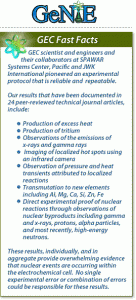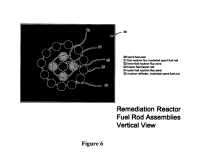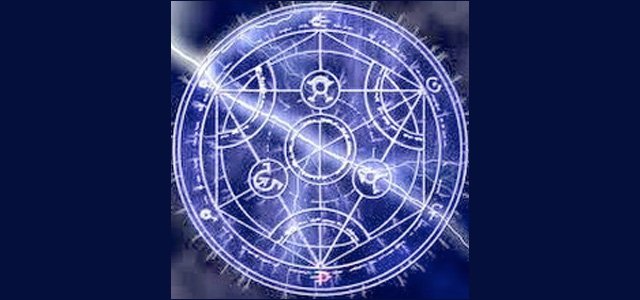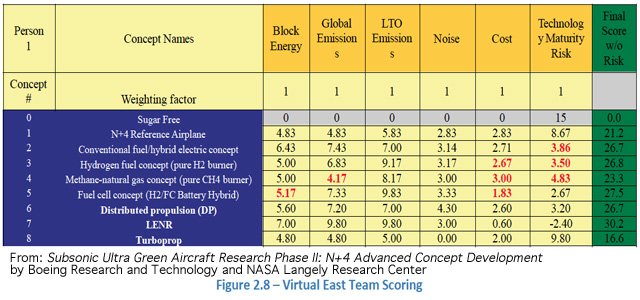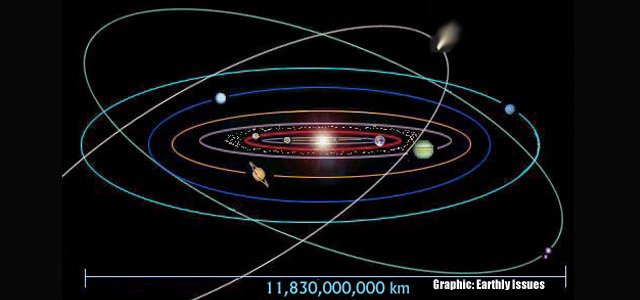The United States of America Navy LENR energy patent is noteworthy. The transmutation of radioactive waste to benign elements through LENR low energy nuclear reactions is of global importance. With the continuing Fukushima disaster, inadequate storage of spent fuel rods, and the plutonium sludge leaks at the Hanford Nuclear Reservation site; each which threaten planetary health, our government should be fast-tracking the LENR remediation of nuclear waste. This technology should be brought forward with broad disclosure and international involvement. The U.S. has not made broad disclosure and is thereby stalling international collaboration in development of this important nuclear waste and pollution remediation, a cold fusion technology.
Can we trust the DoE to do it right this time?
NAVY LENR Patent Granted – Transmutes Radioactive Waste
Ruby read the previous article and had this to say
Ruby Carat July 9, 2013 at 11:32 AM
“Who will license this???”
“Somebody – please!” see GEC Fast Facts
The Global Energy Corporation Has Use of Patent
Companies working with U.S. governmental agencies developing technology have first consideration as patent licensing takes place.
Global Energy Corporation is utilizing the LENR nuclear waste remediation technology developed at SPAWAR. Lawrence Parker Galloway Forsley of Global Energy Corporation along with JWK International have worked with SPAWAR developing this technology for decades. Following many years of research and development the Navy patent was filed in 2007. Department of Energy funded SPAWAR LENR research has most likely been continuous since the 1989 announcement of cold fusion.
The DoE has controlled the release of information pertaining to this technology since before 2007, keeping it from the eyes of the public. It is well known that the DoE discredited Pons and Fleischmann in 1989 and has continued to marginalize LENR through search engine censorship and misinformation.
Quote Global Energy Corporation, “This manuscript has been co-authored by National Security Technologies, LLC, under Contract No. DE-AC52-06NA25946 with the US Department of Energy. The United States Government retains and the publisher, by accepting the article for publication, acknowledges that the United States Government retains a non-exclusive, paid-up, irrevocable, worldwide license to publish or reproduce the published form of this manuscript, or allow others to do so, for United States Government purposes.”
We have been lied to about cold fusion research at SPAWAR. (see Navy Commander Halts SPAWAR LENR Research Posted on March 1, 2012 New Energy Times). We have been misled about the value of pursuing LENR Energy. Historians will investigate those responsible for this. We will eventually understand why the Department of Energy of the United States of America has secretly coveted while publicly denouncing the science of cold fusion.
We the People, as the Government of the United States of America, would certainly like to see our State and Federal representatives, fellow citizens, scientific institutions, as well as the nuclear regulatory agencies and political leaders of all nations to be informed of this nuclear remediation technology now.
Furthermore
We the Peoples of the United States of America, as owners of this important technology, certainly do not want it to be hidden or marginalized any more. Contrary to the DoE and their method, the truth should be told about LENR. International development should be sought and licensing agreements offered widely to utilize this technology. A Congressional sub-committee should be formed seeking international cooperation in making this technology available, worldwide, as quickly as possible.
The Lawrence Parker Galloway Forsley LENR Patent
A HYBRID FUSION FAST FISSION REACTOR (View it here)
A hybrid nuclear fusion fast fission reactor is disclosed. The hybrid reactor may include an electrolyte solution comprised of PdCI2 a conductive salt and D2O, an anode of a noble metal, a cathode consisting of a conductive high Z (atomic number greater than 46) material wound around a deuteride-forming actinide nuclear fuel element, a power source providing constant current to the + anode and the – cathode, an applied power profile for fabricating the PdD nanoalloy, and a co-deposition of a PdD nanoalloy on to the high Z cathode winding as well as the nuclear fuel element. A preferred embodiment stablizes the actinide deuteride nuclear fuel element from hydrogen isotope de-loading. A preferred embodiment initiates deuterium-deuterium fusion in the deuterized fuel element and fissioning deuterized fuel element actinides. A preferred embodiment includes surrounding spent nuclear fuel elements with deuteride nuclear fuel elements that will fast fission the spent fuel elements. Another preferred embodiment includes surrounding the deuteride nuclear fuel elements with spent fuel elements as fast neutron reflectors that will also fission.
Claims
What’s Claimed Is
1. A hybrid nuclear fusion fast fission reactor in a vessel comprising:
an electrolyte solution comprised of PdCb a conductive salt and D2O;
-
an anode of a conductive noble metal provided within said electrolyte solution;
-
a cathode comprising a conductive high Z (atomic number greater than 46) material wound around a metallic actinide nuclear fuel element;
-
a power source providing constant current to the + anode and the -cathode;
-
an applied power profile for fabricating the PdD nano-alloy; and
-
an electrolytically co-deposited PdD nano-alloy on to the high Z cathode winding and on said fuel element.
2. A hybrid nuclear fusion fast fission reactor as claimed in claim 1 wherein said cathode wound around said fuel element acts as a neutron generator and said cathode is comprised of a composition of the non-deuteriding series selected from the group consisting of platinum, gold, mercury, lead and bismuth.
3. A hybrid nuclear fusion fast fission reactor as claimed in claim 1 wherein the nuclear fuel element is electrolytically deuterided beyond the actinide-deuterium beta phase.
4. A deuterided nuclear fuel element adapted by the electrolytic loading of deuterium to provide lattice fluctuations which initiate primary and secondary deuterium-deuterium fusion reactions at sites in the actinide metal lattice producing fast neutrons.
5. A deuterided fuel element as claimed in claim 4 where said fast neutrons fission the actinides comprising said nuclear fuel element.
6. A deuterided fuel element as claimed in claim 5 then sealed with an amalgam of compounds to prevent isotopic hydrogen deloading through desorption.
7. The deuterided fuel element of claim 6 further comprising an apparatus for pulsed control that produces acoustic, thermal, radiofrequency or other emanations attached to the deuterided fuel element and periodically enhancing local actinide-deuterium loading resulting in deuteron fluctuations producing primary and secondary deuterium-deuterium fusion reactions and neutrons.
8. A deuterided fuel element as claimed in claim 7 where said neutrons fission the actinides comprising said fuel element.
9. A plurality of said deuterided fuel elements as claimed in claim 8 arranged to irradiate and fission a spent nuclear fuel element, or a plurality of nuclear spent fuel elements, with fast primary and secondary deuterium-deuterium fusion reaction neutrons.
10. A plurality of said spent nuclear fuel elements arranged around said deuterided fuel elements claimed in claim 9 to act as fast neutron reflectors while also fissioning said spent fuel elements.
11. A nuclear spent fuel pool comprised of a plurality of said spent fuel elements and deuterided fuel elements as claimed in claim 10.
12. A method for removing heat generated by the primary and secondary deuterium-deuterium fusion reactions in said deuterided fuel elements and from fast neutron fission of said spent fuel elements.
Abstract Highlight Terms
Chemicals (link)
A hybrid nuclear fusion fast fission reactor is disclosed. The hybrid reactor may include an electrolyte solution comprised of PdCI2 a conductive salt and D2O, an anode of a noble metal, a cathode consisting of a conductive high Z (atomic number greater than 46) material wound around a deuteride-forming actinide nuclear fuel element, a power source providing constant current to the + anode and the – cathode, an applied power profile for fabricating the PdD nanoalloy, and a co-deposition of a PdD nanoalloy on to the high Z cathode winding as well as the nuclear fuel element. A preferred embodiment stablizes the actinide deuteride nuclear fuel element from hydrogen isotope de-loading. A preferred embodiment initiates deuterium-deuterium fusion in the deuterized fuel element and fissioning deuterized fuel element actinides.; A preferred embodiment includes surrounding spent nuclear fuel elements with deuteride nuclear fuel elements that will fast fission the spent fuel elements. Another preferred embodiment includes surrounding the deuteride nuclear fuel elements with spent fuel elements as fast neutron reflectors that will also fission.
Publications
Publications by Global Energy Corporation and collaborators at SPAWAR Systems Center, Pacific and JWK International
Although it has sometimes been difficult to publish in a controversial field, by conducting careful experiments and reporting the results, Global Energy Corporation collaborators at the U.S. Navy SPAWAR Systems Center Pacific and its predecessors and JWK International have published 24 peer-reviewed papers in seven technical journals and two book chapters. Our publication record documents steady progress in conducting experiments to demonstrate ever-increasing evidence that nuclear reactions can be stimulated using low energies in an electrochemical cell. Our most recent paper uses CR-39 to record and compare the impacts of high-energy particles produced in our pilot GeNiE reactor with neutrons from a known D-T fusion source.
P.A. Mosier-Boss, J.Y. Dea, L.P.G. Forsley, M.S. Morey, J.R. Tinsley, J.P. Hurley, and F.E. Gordon, “Comparison of Pd/D Co-Deposition and DT Neutron Generated Triple Tracks Observed in CR-39 Detectors,” Eur. Phys. J. Appl. Phys. 51 (2010) 20901.
Abstract
Solid state nuclear track detectors (SSNTDs), such as CR-39, have been used to detect energetic charged particles and neutrons. Of the neutron and charged particle interactions that can occurin CR-39, the one that is the most easily identifiable is the carbon breakup reaction. The observation of a triple track, which appears as three alpha particle tracks breaking away from a center point, is diagnostic of the 12C(n,n’) 3α carbon breakup reaction. Such triple tracks have been observed in CR-39 detectors that have been used in Pd/D co-deposition experiments. In this communication, triple tracks in CR-39 detector sobserved in Pd/D co-deposition experiments are compared with those generated upon exposure to a DT neutron source. It was found that both sets of tracks were indistinguishable. Both symmetric and asymmetric tracks were observed. Using linear energy transfer (LET) curves and track modeling, the energy of the neutron that created the triple track can be estimated.
Acknowledgements
This work was funded by the SPAWAR Systems Center Pacific ILIR and S&T Initiatives Programs, the Defense Threat Reduction Agency (DTRA), and JWK Corporation. The authors would also like to thank Dr. G. Phillips, nuclear physicist, retired from the Naval Research Laboratory, US Navy, Radiation Effects Branch, and P. Carbonnelle fromUniversité catholique de Louvain for valuable discussions in interpreting the optical data. It was G. Phillips who first pointed out the existence of triple tracks in our CR-39 photomicrographs. The authors acknowledge the contributions of Dr. S. Szpak, retired from SPAWAR Systems Center Pacific, who pioneered the Pd/D co-deposition process. This manuscript has been co-authored by National Security Technologies, LLC, under Contract No. DE-AC52-06NA25946 with the US Department of Energy. The United States Government retains and the publisher, by accepting the article for publication, acknowledges that the United States Government retains a non-exclusive, paid-up, irrevocable, worldwide license to publish or reproduce the published form of this manuscript, or allow others to do so, for United States Government purposes.
Technology
GeNiE Reactor technology is based on 20 years of experimental research by Global Energy Corporation, JWK International, and SPAWAR Systems Center San Diego scientists and engineers. The results have been published in over 20 peer-reviewed technical journal articles. Our most recent publications document the ability to efficiently produce high-energy neutrons that are capable of fissioning uranium. We have answered the critical scientific questions:
Our experiments are repeatable.
Our experiments have been replicated by others.
Our experiments provide direct evidence that nuclear reactions are involved including the production of high-energy neutrons. Although our experimental results are not predicted by current nuclear physics theories, the results are real.
The GeNiE Reactor takes advantage of the efficiently produced high-energy neutrons in a proprietary hybrid fusion, fast-fission reactor design to produce power from un-enriched uranium. The GeNiE Reactor is not prone to melt down since it doesn’t rely on a chain-reaction to produce high-energy neutrons. The GeNiE Reactor will extract more energy from the fuel than conventional nuclear Reactors. The GeNiE Reactor is lower cost since it doesn’t required enriched uranium and it doesn’t produce hazardous nuclear waste that is costly to handle. By fissioning existing hazardous waste, the GeNiE Reactor can generate power and mitigate existing hazardous waste at the same time. And by eliminating the need for enrichment, the GeNiE Reactor removes all requirements for uranium enrichment except for weapons production, thereby removing the uncertainty in the purpose of enrichment programs such as the current program in Iran.
Global Energy Corporation and their collaborators are currently experimenting with small pilot GeNiE Reactors and are designing prototype GeNiE Reactors for commercial applications. While there are numerous products possible, GEC is currently focusing on the GeNiE Hybrid Fusion, Fast-Fission Reactor that will use either natural uranium or existing hazardous waste as fuel.
FAQ
(The facts according to the Global Energy Corporation)
Q. This sounds like Cold Fusion. Wasn’t “Cold Fusion” disproven?
A. While most people think that the Department of Energy concluded that the claims were wrong, this is not the case. In fact, after two reviews in 1989 and 2004, the DOE ENERGY RESEARCH ADVISORY BOARD found that there wasn’t enough evidence to either prove or disprove the claims and that more research was needed. Furthermore, several other countries are awaking to the fact that the phenomena may be real as documented in a recent DEFENSE INTELLIGENCE AGENCY TECHNOLOGY ALERT paper. GEC scientists and collaborators developed a different experimental protocol that allowed them to go beyond the initial claims of Fleischmann and Pons. Our experiments are repeatable, they have been replicated by others and our results have been published in peer-reviewed papers. Additionally, our experiments produce direct evidence of nuclear activity including emission of high-energy neutrons.
Q. How can this be real since it doesn’t match theory?
A. History is full of examples where the accepted theory had to be adapted to match new experimental results. At one time, theory held that the earth was flat. Galileo was put under house arrest by the church for observing that the earth was not the center of the universe. Cassini and other scientists held that the speed of light was infinite long after Romer had provided solid experimental evidence that it was 186,000 miles per second. There’s a statement in science that, “Theory guides, experiment decides.” A theory is only as good as its ability to predict or describe experimental results. If the experimental results don’t confirm the theory, it’s the theory that must change since the experimental results are controlled by nature. This is not to say that all current nuclear physics theories are wrong but that they are incomplete when it comes to explaining our experimental results. Each year, hundreds of PhD’s are awarded to students who have improved or evolved a theory so that it more accurately explains experimental results. These and many other examples show how theory must evolve to match observation. Several theories have been proposed but to date, none match all of our observed experimental results.
Q. How do you overcome the coulomb barrier?
A. Several possibilities such as a stripping reaction or the equivalent to “tunneling” in solid state electronics have been suggested as a way to overcome the coulomb barrier. More research is needed to determine the answer to this question.
Q. What technical challenges need to be overcome before this technology can be commercialized?
A. Our GeNiE pilot reactors have demonstrated the ability to produce neutrons with enough energy to fission either natural uranium, enriched uranium, or existing hazardous waste. We are currently working to optimize the reactions and increase the flux of high-energy neutrons. Once this is achieved, many commercial applications are possible.
Q. If this is real, you should all be dead because of the neutrons that would have been produced. How do you answer that since you’re obviously still alive?
A. One of the properties of our experiments is that the neutron flux is several orders of magnitude less than that predicted by conventional theory. The current flux levels are not hazardous however we are currently working to optimize the experiments to increase the flux. We recognize the dangers of high-energy neutrons and take appropriate precautions.
National Security Technologies
National Security Technologies, LLC (NSTec) was formed in 2006 as a joint venture between Northrop Grumman Corporation, and three other corporate partners. These partners are AECOM, CH2M Hill, and Babcock & Wilcox (B&W). With some 2,450 employees, NSTec manages operations at the 1,360-square-mile Nevada National Security Site, 65 miles northwest of Las Vegas, and at its related facilities and laboratories for the U.S. Department of Energy (DOE), National Nuclear Security Administration, Nevada Site Office. The company has satellite offices in Los Alamos and Albuquerque, New Mexico; Santa Barbara and Livermore, California; and Washington, D.C., along with a small number of employees located in nine other states and two foreign countries.
Our mission includes homeland security and defense applications, defense experimentation and nuclear weapons stockpile stewardship, as well as environmental management. We specialize in training our nations experts and testing new technologies to detect weapons of mass destruction (WMD), and to mitigate and manage the consequences posed by WMDs once they are detected. We are also equipped to conduct arms control verification testing as well as training of arms control inspectors. NSTec frequently teams on projects with Lawrence Livermore National Laboratory, Los Alamos National Laboratory, and Sandia National Laboratories. In addition, the company works on projects for other federal agencies such as the Defense Threat Reduction Agency, NASA, Department of Defense, Department of State, the Nuclear Regulatory Commission, and the U.S. Air Force, Army, and Navy.
We are also committed to fulfilling our role as a responsible corporate citizen through support of charitable organizations, primarily in the areas where we live and work. At NSTec, we focus on three key areas to achieve more effective results: education, civic and community relations, and diversity.
The Naval, Joint and National knowledge superiority through quality research, development, acquisition, test and evaluation (RDAT&E) and full life cycle support of effective Command, Control, Communications, Computers, Intelligence, Surveillance and Reconnaissance (C4ISR), Information Operations (IO), Enterprise Information Services (EIS) and Space capabilities.
SPAWAR Systems Center Pacific
Our Mission: Enable Information Dominance for our Naval, Joint, National and Coalition warfighters through research, development, delivery and support of integrated capabilities.
Our Vision: SSC Pacific will be the Nation’s pre-eminent Technical Leader for Integrated C4ISR Solutions for Warfighters.
Defense Threat Reduction Agency
DTRA is the U.S. Department of Defense’s official Combat Support Agency for countering weapons of mass destruction. Our people are Subject Matter Experts on WMD, and we address the entire spectrum of chemical, biological, radiological, nuclear and high yield explosive threats. DTRA’s programs include basic science research and development, operational support to U.S. warfighters on the front line, and an in-house WMD think tank that aims to anticipate and mitigate future threats long before they have a chance to harm the United States and our allies. SCC-WMD, the U.S. Strategic Command Center for Combating Weapons of Mass Destruction, synchronizes Combating Weapons of Mass Destruction efforts across our military’s geographic commands and leverages the people, programs and interagency relationships of DTRA at a strategic level. We work with the military services, other elements of the United States government, and countries across the planet on counterproliferation, nonproliferation and WMD reduction issues with one goal in mind: Making the World Safer.
Since DTRA stood up in October 1998 and SCC-WMD in August 2005, the Department of Defense and other federal agencies have increasingly looked to both for support and advice. Both organizations’ responsibilities span the full range of activities necessary to combat and respond to WMD proliferation and use. At home and abroad, DTRA and SCC-WMD deliver mission success against a very real and growing threat.
JWK Corporation
(JWK) has provided reliable, high quality professional services to our customers for over 30 years. Our customers, which include the Department of Defense, numerous U.S. government agencies, and various commercial and foreign enterprises, have come to realize that JWK stands for high quality, affordable technical expertise.
JWK has earned a reputation for technical excellence and cost effective operations by ensuring our customers receive the benefits of a highly qualified, affordable technical workforce, high quality products, and on time delivery. After many years of successful service contract work we are now pleased to be able to offer the full range and depth of our experience and our cost effective labor schedules to the General Services Administration.
Our emphasis on efficient, responsive management helps to ensure our client’s satisfaction. JWK honors our commitments.
JWK has traditionally provided and will continue to provide professional and technical services related to engineering, computing, telecommunications and information technology, health care and education, transportation and energy, environmental protection, intelligence, logistics, and operations and maintenance. These diverse disciplines have provided the background for JWK to focus on innovative, “high end” technology solutions that will provide a paradigm shift in strategies and solutions for our clients. Some of our technologies are uniquely our own, proprietary innovation. In some cases, we integrate other available technologies to develop “technology packages” for specific solutions.
Follow Navy LENR part III
“Energy Shortage – LENR Cold Fusion – Navy Guam”
-
MONDAY, 13 FEB 2012
-
THE Consolidated Commission on Utilities and the Guam Power Authority are investigating a new type of “generation five” nuclear power generator – one that could potentially reduce power costs for Guam ratepayers by half or more.
-
The Variety has learned Dr. Jay W. Khim, CEO of Global Energy Corp. (GEC) based in Annandale, Va., made a presentation to the utilities commission, GPA officials and Navy engineers last month and will make another tomorrow afternoon.
-
CCU member Eloy Hara, who says he is “spearheading” the project on behalf of GEC, told Variety: “After the presentation that Dr. Khim gave to the CCU and the Guam power management team, and almost an hour-long discussion afterward … we were all awed by the technology.


